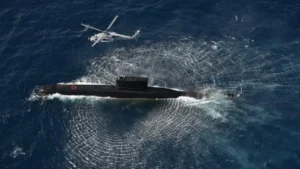As global naval strategies evolve, comparisons between iconic warships often dominate military analysis. One of the most compelling matchups today is between Russia’s Kirov-class nuclear-powered cruisers and America’s Zumwalt-class stealth destroyers. Though differing in design philosophy, size, and age, both vessels symbolize their nations’ approach to modern maritime dominance.
This article examines the Kirov-class cruiser vs Zumwalt-class destroyer, focusing on firepower, technology, defensive capabilities, and strategic relevance in the 21st-century naval theater.
1. Overview of the Kirov-Class Cruiser
Introduction
The Kirov-class cruiser is a product of Soviet-era ambition. Designed in the late 1970s, these massive warships remain the largest and most heavily armed surface combatants in the world, excluding aircraft carriers. Powered by nuclear reactors, the Kirov-class serves as a floating fortress equipped for anti-ship, anti-air, and land-attack missions.
Key Specifications
- Displacement: Approximately twenty-four thousand tons (full load)
- Length: Two hundred fifty-two meters
- Propulsion: Two nuclear reactors plus steam turbines
- Crew: Over seven hundred officers and sailors
- Speed: Around thirty-two knots
- Commissioned Ships: Pyotr Velikiy is active; Admiral Nakhimov is undergoing modernization
2. Overview of the Zumwalt-Class Destroyer
Introduction
The Zumwalt-class destroyer represents the United States Navy’s vision of the future. Commissioned in the 2010s, this ship features stealth technology, electric propulsion, and automated systems that dramatically reduce crew requirements. Despite a smaller displacement compared to Kirov, Zumwalt is packed with advanced electronics and modular weapon systems.
Key Specifications
- Displacement: Approximately fifteen thousand tons
- Length: One hundred eighty-six meters
- Propulsion: Integrated Power System (IPS) using gas turbines
- Crew: About one hundred forty
- Speed: Approximately thirty knots
- Commissioned Ships: Three ships built; USS Zumwalt, USS Michael Monsoor, USS Lyndon B. Johnson
3. Weapons and Firepower Comparison
Kirov-Class Firepower
The Kirov-class is often described as a battlecruiser because of its extensive missile arsenal and defensive depth.
- Anti-Ship Missiles: Up to twenty P-700 Granit missiles
- Air Defense: S-300F and 3K95 Kinzhal surface-to-air missiles
- Anti-Submarine Warfare: RBU-6000 rocket launchers, torpedoes
- Guns: One AK-130 dual-purpose naval gun
- CIWS: Multiple Kashtan and AK-630 systems for close-in defense
The combination of long-range anti-ship and air-defense systems makes the Kirov a multi-layered threat in open waters.
Zumwalt-Class Firepower
The Zumwalt-class emphasizes precision and modular capability, though some weapon systems have been limited due to funding or mission changes.
- Main Gun: Two Advanced Gun Systems (AGS) designed for long-range land attack
- Missile Launchers: Eighty Vertical Launch System (VLS) cells
- Missiles Supported: Tomahawk cruise missiles, Evolved Sea Sparrow, SM series for anti-air and surface warfare
- Torpedoes: Lightweight torpedo launchers
- Planned Additions: Hypersonic missile integration underway
While the Zumwalt’s AGS is underused due to the lack of available munitions, its VLS cells provide flexible strike options, including anti-submarine, anti-aircraft, and land-attack missions.
4. Defensive Systems and Survivability
Kirov-Class Defense
The Kirov relies on layers of missile and gun-based defenses. Systems like S-300F provide long-range coverage, while close-in systems offer terminal-stage protection. However, its size and outdated electronic countermeasures may make it vulnerable to modern stealth or hypersonic weapons.
Zumwalt-Class Defense
Zumwalt uses stealth shaping and radar-absorbing materials to drastically reduce its radar cross-section. It also features:
- Integrated electronic warfare systems
- Advanced decoys and jammers
- Automation for damage control
Although less heavily armored, the Zumwalt is harder to detect and target, relying more on avoidance than brute force.
5. Technological Innovation
- Kirov-class: Emphasizes raw firepower and endurance. Its nuclear propulsion offers unlimited range, but it features older Soviet-era systems with limited stealth or AI support.
- Zumwalt-class: Showcases cutting-edge naval design. Its Integrated Power System allows future upgrades, including directed energy weapons and electromagnetic railguns.
While Kirov leads in sheer arsenal size, Zumwalt pushes the boundary in low-observable tech and adaptability.
6. Strategic Roles and Deployment
Russia’s Kirov-Class
Kirov-class cruisers serve as flagships for fleet operations. With massive firepower and nuclear propulsion, they are intended to challenge carrier strike groups and assert presence in contested maritime zones, especially the Arctic and North Atlantic.
America’s Zumwalt-Class
Zumwalt is designed for littoral dominance and precision strike. Its stealth and automation allow it to operate in contested near-shore environments where traditional ships might be too vulnerable.
7. Cost and Operational Efficiency
- Kirov-class: Expensive to operate due to nuclear systems and large crew requirements. Its high maintenance costs have limited active deployments.
- Zumwalt-class: Costly to build due to R and D, but designed for long-term savings through automation and modularity. However, only three ships were produced out of an initially planned thirty-two.



 Indian Navy to Commission INAS 335 (Ospr...
Indian Navy to Commission INAS 335 (Ospr...
 Indian Navy to Commission First Indigeno...
Indian Navy to Commission First Indigeno...
 Rajnath Singh Inaugurates 125 Border Inf...
Rajnath Singh Inaugurates 125 Border Inf...







